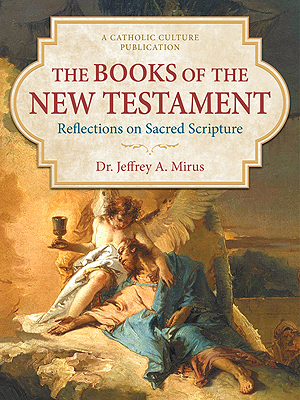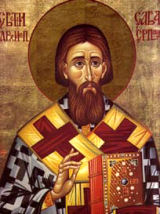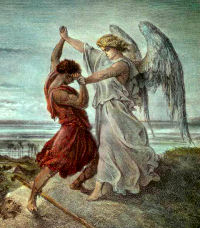Advent: December 5th
Saturday of the First Week of Advent
Other Commemorations: St. Sabbas, Abbot (RM)
Free eBook:

|
| Free eBook: The Books of the New Testament |
» Enjoy our Liturgical Seasons series of e-books!
St. Sabas, one of the most renowned patriarchs of the monks of Palestine, was born in the year 439, near Cæsarea. In order to settle a dispute which had arisen between some of his relatives in regard to the administration of his estate, while still young he forsook the world and entered a monastery, wherein he became a model of fervor. His great sanctity becoming known, he was ordained priest, at the age of fifty-three, by the patriarch of Jerusalem, and made Superior-General of all the anchorites of Palestine. He lived to be ninety-four, and died on the 5th of December, 532. He is distinguished by the titles "God-bearer, the Saint, Citizen of the Holy City, Star of the Desert, Patriarch of Monks." According to the the Extraordinary Form of the Roman Rite today is his feast.
St. Sabbas
 Saint Sabbas the Sanctified was born in the fifth century in Cappadocia, in the pious Christian family of John and Sophia. His father was a military commander. Journeying to Alexandria on military matters, his wife went with him, but they left their five-year-old son in the care of an uncle. When the boy reached eight years of age, he entered the monastery of St. Flavian, located nearby. The gifted child quickly learned to read and became an expert on the Holy Scriptures. In vain did his parents urge St. Sabbas to return to the world and enter into marriage. At seventeen years of age he received monastic tonsure, and attained such perfection in fasting and prayer that he was given the gift of wonderworking. After spending ten years at the monastery of St. Flavian, he went to other monasteries. St. Sabbas lived in obedience at this monastery until the age of thirty.
Saint Sabbas the Sanctified was born in the fifth century in Cappadocia, in the pious Christian family of John and Sophia. His father was a military commander. Journeying to Alexandria on military matters, his wife went with him, but they left their five-year-old son in the care of an uncle. When the boy reached eight years of age, he entered the monastery of St. Flavian, located nearby. The gifted child quickly learned to read and became an expert on the Holy Scriptures. In vain did his parents urge St. Sabbas to return to the world and enter into marriage. At seventeen years of age he received monastic tonsure, and attained such perfection in fasting and prayer that he was given the gift of wonderworking. After spending ten years at the monastery of St. Flavian, he went to other monasteries. St. Sabbas lived in obedience at this monastery until the age of thirty.
He was later blessed to seclude himself in a cave. On Saturdays, however, he left his hermitage and came to the monastery, where he participated in divine services and ate with the brethren. After a certain time St. Sabbas received permission not to leave his hermitage at all, and he struggled in the cave for five years. After several years, disciples began to gather around St. Sabbas, seeking the monastic life. As the number of monks increased, a lavra sprang up. When a pillar of fire appeared before St. Sabbas as he was walking, he found a spacious cave in the form of a church.
St. Sabbas founded several more monasteries. Many miracles took place through the prayers of St. Sabbas: at the Lavra a spring of water welled up, during a time of drought there was abundant rain, and there were also healings of the sick and the demoniacs. The saint surrendered his soul to God in the year 532.
Symbols and Representation: Abbot with an apple; man holding the rule of his monastery in his hand; man seated at the edge of a cliff; man praying in a cave with a lion nearby
Highlights and Things to Do:
- Learn about the icon of the Mother of God called the "Milk-Giver" and its connection to St. Sabbas.
- Make preparations for the feast of St. Nicholas. Tonight many families put out their shoes or stockings for St. Nicholas to fill. Also many families celebrate with a party on St. Nicholas Eve.
- Don't forget to pray "Hail and Blessed be the hour...", the Christmas Anticipatory Prayer every day until Christmas.
- Read more about St. Sabas:
- Read this longer biography of St. Sabas to find out why he is pictured with an apple.
- Read St. Sabbas the Sanctified and his Holy Lavra.
- Visit this site to learn more about the ancient monastery established in the 5th century by St. Sabas.







